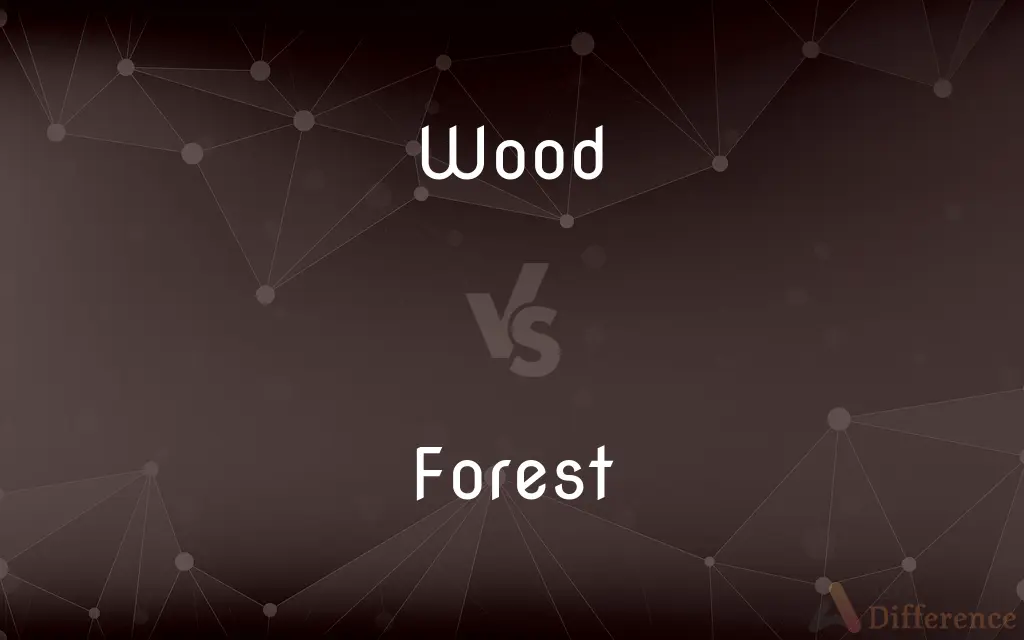Wood vs. Forest — What's the Difference?
By Fiza Rafique & Maham Liaqat — Updated on March 16, 2024
Wood is a hard, fibrous material from trees, used in construction and making items; a forest is a large area covered predominantly with trees and undergrowth.

Difference Between Wood and Forest
Table of Contents
ADVERTISEMENT
Key Differences
Wood is the material derived from the trunk and branches of trees and is utilized extensively in construction, furniture, and many other applications. It's valued for its strength, durability, and aesthetic appeal. Whereas, a forest encompasses a much broader concept, referring to a large area dominated by trees, underbrush, and wildlife, serving as crucial ecosystems for the planet.
While wood is measured and valued by its type, quality, and the specific uses it can be put to—ranging from building materials to paper production—forests are categorized based on their ecological function, biodiversity, and climate, such as rainforests, temperate forests, and boreal forests.
The extraction of wood from forests is a significant economic activity, driving industries like lumber, paper, and furniture. On the other hand, forests contribute far beyond economic value, playing vital roles in carbon sequestration, oxygen production, and as habitats for countless species.
Sustainability practices in wood production focus on minimizing waste and promoting reforestation to ensure that wood resources do not deplete. Meanwhile, forest conservation efforts aim to protect these ecosystems from deforestation, fragmentation, and other threats, highlighting the delicate balance between utilizing and preserving these natural resources.
Wood's characteristics, such as grain, color, and hardness, are important considerations for craftsmen and builders, influencing its suitability for various applications. In contrast, the diversity within a forest, including types of trees, undergrowth, and animal species, defines its ecological identity and health.
ADVERTISEMENT
Comparison Chart
Definition
Hard, fibrous material from trees.
Large area covered with trees and undergrowth.
Use/Application
Construction, furniture, paper.
Ecosystem services, biodiversity conservation.
Value
Measured by type, quality, use.
Ecological function, biodiversity, climate regulation.
Sustainability
Focus on reforestation, minimizing waste.
Conservation efforts against deforestation.
Characteristics
Grain, color, hardness.
Types of trees, biodiversity, ecological health.
Compare with Definitions
Wood
Material made from the trunk or branches of trees, used for building.
The cabin was constructed with pine wood.
Forest
Large area dominated by trees and undergrowth.
The Amazon rainforest is the largest forest in the world.
Wood
Refers to the small forest or collection of trees.
We took a walk through the wood behind the house.
Forest
Subject to conservation efforts to protect biodiversity.
The national park was established to protect the forest and its inhabitants.
Wood
Used in making furniture due to its durability and aesthetic.
The table is made of solid oak wood.
Forest
Plays a crucial role in Earth's carbon cycle.
Forests absorb significant amounts of CO2, mitigating climate change.
Wood
Hard, fibrous substance beneath the bark in trees.
The wood of this tree is particularly strong.
Forest
Classified by type such as rainforest, boreal, and temperate.
The Black Forest in Germany is a famous temperate forest.
Wood
Wood products include paper, tools, and crafts.
The artist carved the sculpture from a single piece of wood.
Forest
Provides habitat for a wide range of species.
This forest is home to many endangered animals.
Wood
Wood is a porous and fibrous structural tissue found in the stems and roots of trees and other woody plants. It is an organic material – a natural composite of cellulose fibers that are strong in tension and embedded in a matrix of lignin that resists compression.
Forest
A forest is an area of land dominated by trees. Hundreds of definitions of forest are used throughout the world, incorporating factors such as tree density, tree height, land use, legal standing and ecological function.
Wood
The hard fibrous material that forms the main substance of the trunk or branches of a tree or shrub, used for fuel or timber
A block of wood
Best quality woods were used for joinery
Forest
A large area covered chiefly with trees and undergrowth
A pine forest
A large tract of forest
Wood
An area of land, smaller than a forest, that is covered with growing trees
A thick hedge divided the wood from the field
A long walk in the woods
Forest
A large number or dense mass of vertical or tangled objects
A forest of high-rise apartments
Wood
The secondary xylem of trees and shrubs, lying beneath the bark and consisting largely of cellulose and lignin.
Forest
Cover (land) with forest; plant with trees
A forested hillside
Wood
This tissue when cut and dried, used especially for building material and fuel.
Forest
A growth of trees and other plants covering a large area.
Wood
A growth of trees and other plants usually covering a smaller area than a forest.
Forest
A large number of objects bearing a similarity to such a growth, especially a dense collection of tall objects
A forest of skyscrapers.
Wood
A forest.
Forest
A defined area of land formerly set aside in England as a royal hunting ground.
Wood
(Music) A woodwind.
Forest
To plant trees on or cover with trees.
Wood
(Sports) Any of a series of golf clubs used to hit long shots, having a bulbous head made of wood, metal, or graphite, and numbered one to five in order of increasing loft.
Forest
A dense uncultivated tract of trees and undergrowth, larger than woods.
Wood
To fuel with wood.
Forest
Any dense collection or amount.
A forest of criticism
Wood
To cover with trees; forest.
Forest
(historical) A defined area of land set aside in England as royal hunting ground or for other privileged use; all such areas.
Wood
To gather or be supplied with wood.
Forest
(graph theory) A graph with no cycles; i.e., a graph made up of trees.
Wood
Made or consisting of wood; wooden.
Forest
A group of domains that are managed as a unit.
Wood
Used or suitable for cutting, storing, or working with wood.
Forest
The colour forest green.
Wood
Woods Living, growing, or present in forests
Woods animals.
A woods path.
Forest
(transitive) To cover an area with trees.
Wood
Mentally deranged.
Forest
An extensive wood; a large tract of land covered with trees; in the United States, a wood of native growth, or a tract of woodland which has never been cultivated.
Wood
(uncountable) The substance making up the central part of the trunk and branches of a tree. Used as a material for construction, to manufacture various items, etc. or as fuel.
This table is made of wood.
There was lots of wood on the beach.
Forest
A large extent or precinct of country, generally waste and woody, belonging to the sovereign, set apart for the keeping of game for his use, not inclosed, but distinguished by certain limits, and protected by certain laws, courts, and officers of its own.
Wood
(countable) The wood of a particular species of tree.
Teak is much used for outdoor benches, but a number of other woods are also suitable, such as ipé, redwood, etc.
Forest
Of or pertaining to a forest; sylvan.
Wood
A forested or wooded area.
A wood beyond this moor was viewed as a border area in the seventeenth century.
He got lost in the woods beyond Seattle.
Forest
To cover with trees or wood.
Wood
Firewood.
We need more wood for the fire.
Forest
The trees and other plants in a large densely wooded area
Wood
A type of golf club, the head of which was traditionally made of wood.
Forest
Land that is covered with trees and shrubs
Wood
(music) A woodwind instrument.
Forest
Establish a forest on previously unforested land;
Afforest the mountains
Wood
Chess pieces.
Wood
A peckerwood.
Wood
(transitive) To cover or plant with trees.
Wood
To hide behind trees.
Wood
(transitive) To supply with wood, or get supplies of wood for.
To wood a steamboat or a locomotive
Wood
(intransitive) To take or get a supply of wood.
Wood
(obsolete) Mad, insane, crazed.
Wood
Mad; insane; possessed; rabid; furious; frantic.
Our hoste gan to swear as [if] he were wood.
Wood
To grow mad; to act like a madman; to mad.
Wood
To supply with wood, or get supplies of wood for; as, to wood a steamboat or a locomotive.
Wood
To take or get a supply of wood.
Wood
A large and thick collection of trees; a forest or grove; - frequently used in the plural.
Light thickens, and the crowMakes wing to the rooky wood.
Wood
The substance of trees and the like; the hard fibrous substance which composes the body of a tree and its branches, and which is covered by the bark; timber.
Wood
The fibrous material which makes up the greater part of the stems and branches of trees and shrubby plants, and is found to a less extent in herbaceous stems. It consists of elongated tubular or needle-shaped cells of various kinds, usually interwoven with the shinning bands called silver grain.
Wood
Trees cut or sawed for the fire or other uses.
We cast the lots . . . for the wood offering.
Wood
The hard fibrous lignified substance under the bark of trees
Wood
The trees and other plants in a large densely wooded area
Wood
United States film actress (1938-1981)
Wood
English conductor (1869-1944)
Wood
English writer of novels about murders and thefts and forgeries (1814-1887)
Wood
United States painter noted for works based on life in the Midwest (1892-1942)
Wood
Any wind instrument other than the brass instruments
Wood
A golf club with a long shaft used to hit long shots; originally made with a wooden head; metal woods are now available
Common Curiosities
What defines a forest?
A forest is defined as a large area covered predominantly with trees, undergrowth, and associated flora and fauna.
What is deforestation?
Deforestation is the clearing or thinning of forests by humans, significantly impacting ecosystems and biodiversity.
How is the sustainability of wood ensured?
Through practices like reforestation, sustainable harvesting, and minimizing waste in wood production.
What is wood used for?
Wood is used in construction, making furniture, and as raw material for paper and various crafts.
Can wood come from any type of tree?
Yes, wood can come from various types of trees, each with different characteristics like hardness, grain, and color.
Are all forests the same?
No, forests vary widely in type (e.g., rainforest, boreal, temperate), biodiversity, and ecological function.
What are the main threats to forests?
Deforestation, climate change, and fragmentation are major threats to forest ecosystems.
Can forests recover from deforestation?
Yes, with proper conservation efforts and reforestation, forests can recover, but it takes many years.
How are forests important to the environment?
Forests play critical roles in carbon sequestration, oxygen production, and providing habitats for biodiversity.
What makes a forest a biodiversity hotspot?
The variety of life forms, including plants, animals, and microorganisms, makes a forest a biodiversity hotspot.
How can individuals contribute to forest conservation?
By supporting sustainable products, participating in tree planting, and advocating for policies that protect forests.
What's the difference between a wood and a forest?
"Wood" refers to the material or a smaller collection of trees, while "forest" denotes a large area filled with trees and wildlife.
Why are forests important for climate change?
Forests absorb CO2, a greenhouse gas, thus playing a significant role in mitigating climate change.
How does wood contribute to the economy?
Wood is a key material in industries such as construction, furniture making, and paper production.
What are the differences in wood types?
Wood types differ in properties like density, grain patterns, color, and durability, affecting their use and value.
Share Your Discovery

Previous Comparison
Advocate vs. Promote
Next Comparison
Bay vs. BrayAuthor Spotlight
Written by
Fiza RafiqueFiza Rafique is a skilled content writer at AskDifference.com, where she meticulously refines and enhances written pieces. Drawing from her vast editorial expertise, Fiza ensures clarity, accuracy, and precision in every article. Passionate about language, she continually seeks to elevate the quality of content for readers worldwide.
Co-written by
Maham Liaqat













































